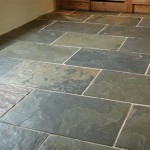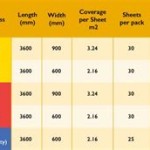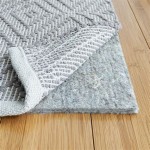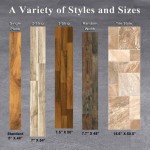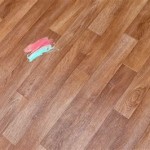Is Carpet Tape Bad For Hardwood Floors?
The use of carpet tape on hardwood floors is a common practice for securing area rugs and preventing slips and falls. However, the long-term effects of this seemingly simple solution can be complex and potentially damaging to the underlying wood. Understanding the properties of carpet tape, the nature of hardwood floor finishes, and the potential interactions between the two is crucial for informed decision-making.
Carpet tape is essentially a double-sided adhesive material designed to bond two surfaces together. It comprises a carrier layer, often made of cloth or plastic film, coated on both sides with an adhesive. The adhesive itself can vary in composition, ranging from rubber-based to acrylic-based formulations. The strength of the adhesive bond and the type of carrier material significantly influence its suitability for use on different surfaces, including hardwood floors.
Hardwood floors are typically finished with a protective coating designed to enhance their appearance and protect them from wear and tear. Common finishes include polyurethane, varnish, lacquer, and wax. These finishes create a barrier between the wood and the environment, preventing moisture absorption and resisting scratches and abrasions. The compatibility of carpet tape with these finishes is a primary concern, as certain adhesive formulations can interact negatively with the finish, leading to damage.
The potential negative consequences of using carpet tape on hardwood floors are varied and depend on several factors, including the type of tape used, the duration of application, the type of floor finish, and the environmental conditions. Some of the most common problems associated with carpet tape application include adhesive residue, finish damage, and, in severe cases, damage to the wood itself.
Adhesive Residue and Removal Challenges
One of the most frequently encountered issues with carpet tape is the residue left behind after removal. The adhesive can bond strongly to the floor finish, making it difficult to remove cleanly. This residue can be sticky, attracting dirt and debris, and can alter the appearance of the floor. The difficulty of removing the residue often depends on the type of adhesive used in the tape. Rubber-based adhesives tend to be more prone to leaving residue than acrylic-based adhesives. Furthermore, the longer the tape remains in place, the more challenging the residue removal becomes as the adhesive bonds more tightly to the floor surface.
Attempts to remove adhesive residue can further damage the floor finish. Aggressive scrubbing, the use of harsh chemicals, or scraping with abrasive tools can scratch, dull, or even strip the finish. This damage can be costly to repair, potentially requiring refinishing of the entire floor. Therefore, careful consideration must be given to the appropriate removal techniques and cleaning agents when dealing with carpet tape residue on hardwood floors.
Specialized adhesive removers are available, designed to dissolve the adhesive bond without harming the floor finish. However, it is crucial to test these products in an inconspicuous area first to ensure compatibility with the specific finish. The effectiveness of these removers can also vary depending on the type of adhesive and the duration of its application. In some cases, multiple applications and prolonged soaking may be necessary to fully remove the residue. Following the manufacturer's instructions carefully is essential to minimize the risk of damage.
Heat can sometimes be used to soften the adhesive, making it easier to remove. However, the application of heat should be done with caution, as excessive heat can damage the floor finish. A hairdryer set on a low setting can be used to gently warm the residue before attempting to scrape it away with a plastic scraper. Avoid using heat guns or other high-temperature devices, as these can cause irreversible damage.
Finish Damage and Discoloration
The adhesive in carpet tape can react chemically with the floor finish, leading to discoloration or softening of the finish. This is particularly common with certain types of polyurethane finishes, which can be susceptible to chemical degradation from prolonged contact with certain adhesives. The reaction can cause the finish to become cloudy, sticky, or even peel away from the wood surface.
The duration of exposure plays a significant role in the severity of the finish damage. The longer the tape remains in place, the greater the opportunity for the adhesive to interact with the finish. In some cases, even short-term application can cause noticeable damage, especially if the tape is exposed to heat or sunlight, which can accelerate the chemical reaction.
The type of floor finish also influences its susceptibility to damage. Wax finishes, for example, are relatively soft and easily damaged by the adhesive in carpet tape. Polyurethane finishes, while generally more durable, can still be affected by certain adhesive formulations. Understanding the type of finish on your hardwood floor is crucial for choosing the appropriate cleaning and maintenance techniques, and for making informed decisions about the use of carpet tape.
Discoloration can also occur due to the tape shielding the floor from sunlight. Over time, the surrounding areas of the floor may lighten or change color due to UV exposure, while the area under the tape remains unchanged. This can create a noticeable difference in appearance once the tape is removed, requiring professional refinishing to restore a uniform color.
Potential Damage to the Wood Itself
In extreme cases, carpet tape can damage the wood itself, particularly if the tape is applied to a poorly sealed or unfinished floor. Moisture can become trapped under the tape, leading to warping, cupping, or even rot of the wood. This is more likely to occur in areas with high humidity or where spills are common.
The adhesive can also penetrate the wood fibers, making it difficult to remove without damaging the surface. Attempts to scrape or sand away the adhesive can create unsightly marks and imperfections in the wood. In severe cases, the damaged wood may need to be replaced, which can be a costly and time-consuming process.
The adhesion strength of some carpet tapes can be so strong that removing the tape can literally pull up splinters or chunks of wood, especially if the floor has existing weaknesses or imperfections. This type of damage is more likely to occur with older floors or those that have been improperly maintained.
Preventive measures are crucial for protecting hardwood floors from damage caused by carpet tape. Using alternative methods for securing area rugs, such as rug pads designed specifically for hardwood floors, can significantly reduce the risk of damage. These pads provide cushioning and prevent the rug from slipping without relying on adhesives that can harm the floor finish. Regular cleaning and maintenance of the hardwood floor can also help to maintain its integrity and prevent moisture from becoming trapped under the rug.
If carpet tape must be used, selecting a low-tack adhesive specifically designed for hardwood floors is recommended. These tapes are formulated to provide sufficient adhesion without leaving excessive residue or damaging the finish. Testing the tape in an inconspicuous area before applying it to the entire floor is also essential to ensure compatibility and prevent unexpected damage.

Pros And Cons Of Applying Rug Tape On Your Floors Carpets Rugpadusa

Flooring How Can I Remove Carpet Adhesive From Hardwood Floors Home Improvement Stack Exchange

Painters Tape Will Pull Hardwood Polyurethane Finish

Pros And Cons Of Applying Rug Tape On Your Floors Carpets Rugpadusa

Pros And Cons Of Applying Rug Tape On Your Floors Carpets Rugpadusa

Will Double Sided Carpet Tile Tape Leave A Sticky Residue Or Damage My Floor

Roberts Rug Gripper 60 Ft Indoor Carpet Tile Solid Hardwood Laminate Vinyl Tape Roll 50 588 The Home

Rug Tape Grip Neutral Mohawk Home Carpet For Area Rugs Hardwood Floors Adhesive Off White 15ft X 2 5in

Roberts Rug Gripper 2 1 In X 25 Ft Antislip Pressure Sensitive Mesh Tape For Small Indoor Rugs 50 580 The Home

Homeeasy 1 875 In X 75 Ft Tan Double Sided Seam Tape 142435 At Com
See Also


